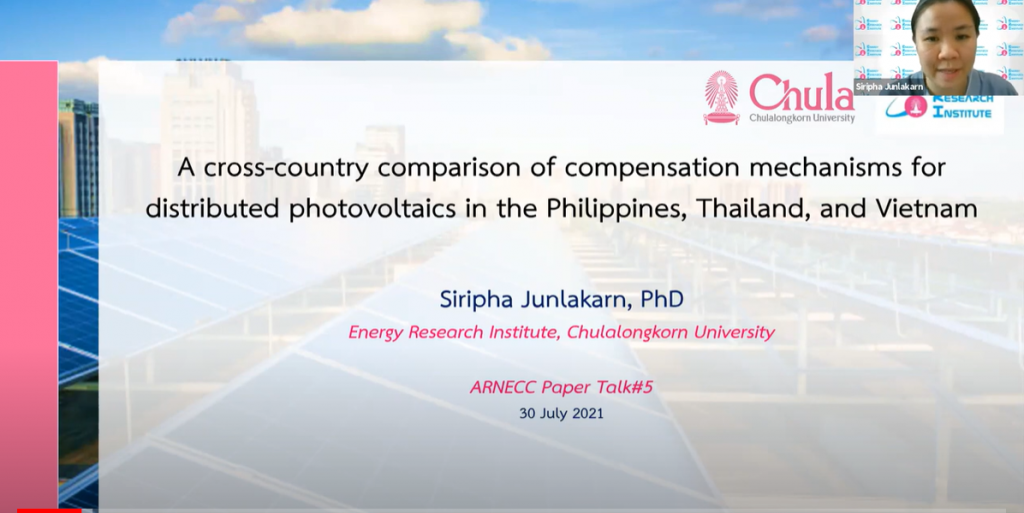Jakarta, 30 July 2021
As one of the efforts in continuing ASEAN Researchers Network on Energy and Climate Change (ARNECC), ASEAN Climate Change and Energy Project (ACCEPT) held the fifth ARNECC Paper Talks on 30 July 2021. The main topic is a recent paper: A cross-country comparison of compensation mechanisms for distributed photovoltaics in the Philippines, Thailand, and Vietnam, which published at Renewable and Sustainable Energy Reviews, volume 145. The author of this paper, who is also a researcher at Energy Research Institute, Chulalongkorn University, Dr. Siripha Junlakarn, was one of the speakers, along with Senior Associate at Vietnam Initiative for Energy Transition, Dr. Trinh Hoang. Dr. Siripha Junlakarn comprehensively explained the paper, continued by comments from Dr. Trinh Hoang and questions from the audience. The event was moderated by ACCEPT Research Analyst, Ms. Monika Merdekawati.

(Photo caption: Paper presentation by Dr. Siripha Junlakarn)
The rapid growth of solar Photovoltaics (PV) deployments with increasing investment and installations and decline cost, allows private individuals, communities, and firms to use Distributed Photovoltaics (DPV) for their own electricity generation. However, policies and regulations are needed to enable DPV technological advances equitable and fair use of the grid. The PV deployment policies and incentives in ASEAN countries is currently focusing on retail tariff design and utility revenue impacts.
This paper highlighted reviews of evolving financial support mechanisms for DPV in the Philippines, Thailand, and Vietnam; policy changes respond to multi-faceted factors, especially utility revenue and rate impacts; the economics of residential and commercial customers under different compensation mechanisms are compared; and current compensation mechanisms incentivise PV under sizing. Discussions on this paper includes overview of compensation mechanism; policies and status of DPV and comparison of economic stability in the three countries; remaining barriers; and policy recommendations.
The DPV compensation mechanisms are buy all, sell all; net metering; and net billing. More precise values to DPV electricity are produced by the net billing mechanism. The Philippines, Thailand, and Vietnam set a threshold on individual DPV system size eligibility for net-billing. However, only Thailand charged a program cap in total. The three countries are expected to advance the existing compensation mechanisms. Furthermore, the quantitative analysis compares the economics of DPV investment at the residential scale under three possible compensation mechanisms: self-consumption, net metering, and net billing. Among the three countries, Thailand’s economics of residential customers are the least attractive. Sizing PV to match with the existing policy or compensation mechanism is one of the critical best practices to achieve the best economics for DPV customers.
There are remaining barriers that need to be addressed. These barriers include policy uncertainties and unclear regulations toward DPV support; concerns over the negative impacts of DPV on electricity rates and equity issues over cross-subsidisation between DPV and non-DPV adopters in Thailand and the Philippines; permission to legitimise DPV in the mainstream with both rate-paying customers and utility operators; and utilities proactive rules/standard for solar PV interconnection.
The value of solar remains a contentious topic and changes over time based on existing market conditions. Therefore, developing new approaches to quantify the value of solar in emerging economies specific to the Southeast Asian policy landscape will help improve DPV compensation mechanism and incentivise adoption. Dynamic export rate design could be a useful policy tool in Southeast Asia since demand for electricity is rising rapidly to feed the initial investment and early adopters. To manage a surge in DPV connections, utility companies could then cap the credits for exported electricity at different capacities.
Questions emerged about factors that influence Vietnam’s lowest levelized cost of energy (LCOE) among the three countries and LCOE for DPV in the three countries compared with the household retail price. Dr. Siripha Junlakarn mentioned that the LCOE does not depend on schemes, it depends on the system cost and energy produced from a PV system. For residential customers, these LCOEs are at grid parity compared to each country’s electricity block rates used in the analysis. The average electricity rates are 0.1123 USD/kWh for Thailand, 0.1771 USD/kWh for the Philippines, and 0.1193 USD/kWh for Vietnam. The commercial PV system LCOE in Thailand has not reached grid parity, while LCOEs of the Philippines and Vietnam are already at grid parity.
Ms. Monika closed the event by promoting ARNECC which address the importance of contemporary energy and climate issues in ASEAN, and the need for interdisciplinary research on such topics. ARNECC links scholars, analyst, researchers, and other stakeholders across ASEAN to enhance broader knowledge and insights related to energy and climate change. Hence, the coherence between the ASEAN energy and climate policies will be improved, contribute to more climate-friendly development of the energy sector.
SNF